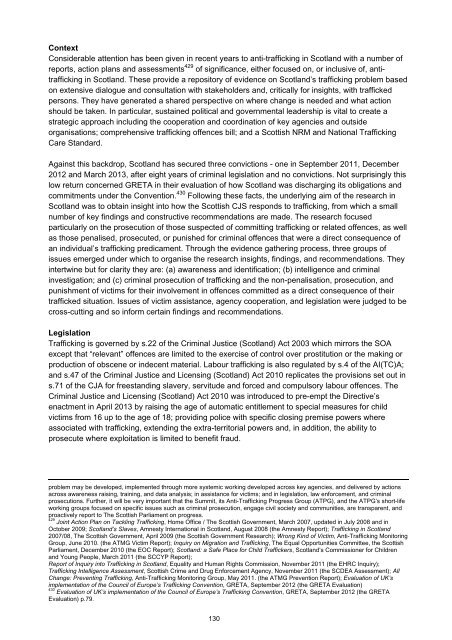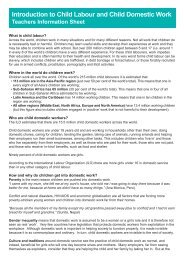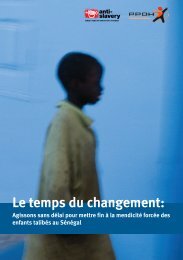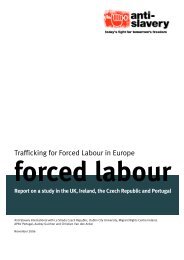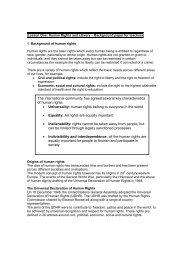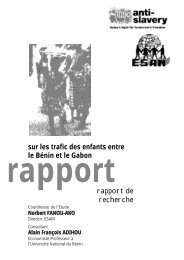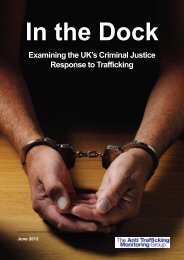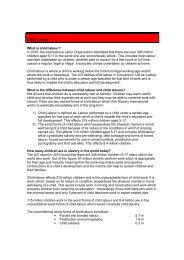ContextConsiderable attention has been given in recent years to anti-trafficking in Scotland with a number ofreports, action plans and assessments 429 of significance, ei<strong>the</strong>r focused on, or inclusive of, antitraffickingin Scotland. These provide a repository of evidence on Scotland’s trafficking problem basedon extensive dialogue and consultation with stakeholders and, critically for insights, with traffickedpersons. They have generated a shared perspective on where change is needed and what actionshould be taken. <strong>In</strong> particular, sustained political and governmental leadership is vital to create astrategic approach including <strong>the</strong> cooperation and coordination of key agencies and outsideorganisations; comprehensive trafficking offences bill; and a Scottish NRM and National TraffickingCare Standard.Against this backdrop, Scotland has secured three convictions - one in September 2011, December2012 and March 2013, after eight years of criminal legislation and no convictions. Not surprisingly thislow return concerned GRETA in <strong>the</strong>ir evaluation of how Scotland was discharging its obligations andcommitments under <strong>the</strong> Convention. 430 Following <strong>the</strong>se facts, <strong>the</strong> underlying aim of <strong>the</strong> research inScotland was to obtain insight into how <strong>the</strong> Scottish CJS responds to trafficking, from which a smallnumber of key findings and constructive recommendations are made. The research focusedparticularly on <strong>the</strong> prosecution of those suspected of committing trafficking or related offences, as wellas those penalised, prosecuted, or punished for criminal offences that were a direct consequence ofan individual’s trafficking predicament. Through <strong>the</strong> evidence ga<strong>the</strong>ring process, three groups ofissues emerged under which to organise <strong>the</strong> research insights, findings, and recommendations. Theyintertwine but for clarity <strong>the</strong>y are: (a) awareness and identification; (b) intelligence and criminalinvestigation; and (c) criminal prosecution of trafficking and <strong>the</strong> non-penalisation, prosecution, andpunishment of victims for <strong>the</strong>ir involvement in offences committed as a direct consequence of <strong>the</strong>irtrafficked situation. Issues of victim assistance, agency cooperation, and legislation were judged to becross-cutting and so inform certain findings and recommendations.LegislationTrafficking is governed by s.22 of <strong>the</strong> Criminal Justice (Scotland) Act 2003 which mirrors <strong>the</strong> SOAexcept that “relevant” offences are limited to <strong>the</strong> exercise of control over prostitution or <strong>the</strong> making orproduction of obscene or indecent material. Labour trafficking is also regulated by s.4 of <strong>the</strong> AI(TC)A;and s.47 of <strong>the</strong> Criminal Justice and Licensing (Scotland) Act 2010 replicates <strong>the</strong> provisions set out ins.71 of <strong>the</strong> CJA for freestanding slavery, servitude and forced and compulsory labour offences. TheCriminal Justice and Licensing (Scotland) Act 2010 was introduced to pre-empt <strong>the</strong> Directive’senactment in April 2013 by raising <strong>the</strong> age of automatic entitlement to special measures for childvictims from 16 up to <strong>the</strong> age of 18; providing police with specific closing premise powers whereassociated with trafficking, extending <strong>the</strong> extra-territorial powers and, in addition, <strong>the</strong> ability toprosecute where exploitation is limited to benefit fraud.problem may be developed, implemented through more systemic working developed across key agencies, and delivered by actionsacross awareness raising, training, and data analysis; in assistance for victims; and in legislation, law enforcement, and criminalprosecutions. Fur<strong>the</strong>r, it will be very important that <strong>the</strong> Summit, its Anti-Trafficking Progress Group (ATPG), and <strong>the</strong> ATPG’s short-lifeworking groups focused on specific issues such as criminal prosecution, engage civil society and communities, are transparent, andproactively report to The Scottish Parliament on progress.429Joint Action Plan on Tackling Trafficking, Home Office / The Scottish Government, March 2007, updated in July 2008 and inOctober 2009; Scotland’s Slaves, Amnesty <strong>In</strong>ternational in Scotland, August 2008 (<strong>the</strong> Amnesty Report); Trafficking in Scotland2007/08, The Scottish Government, April 2009 (<strong>the</strong> Scottish Government Research); Wrong Kind of Victim, Anti-Trafficking MonitoringGroup, June 2010. (<strong>the</strong> ATMG Victim Report); <strong>In</strong>quiry on Migration and Trafficking, The Equal Opportunities Committee, <strong>the</strong> ScottishParliament, December 2010 (<strong>the</strong> EOC Report); Scotland: a Safe Place for Child Traffickers, Scotland’s Commissioner for Childrenand Young People, March 2011 (<strong>the</strong> SCCYP Report);Report of <strong>In</strong>quiry into Trafficking in Scotland, Equality and Human Rights Commission, November 2011 (<strong>the</strong> EHRC <strong>In</strong>quiry);Trafficking <strong>In</strong>telligence Assessment, Scottish Crime and Drug Enforcement Agency, November 2011 (<strong>the</strong> SCDEA Assessment); AllChange: Preventing Trafficking, Anti-Trafficking Monitoring Group, May 2011. (<strong>the</strong> ATMG Prevention Report); Evaluation of UK’simplementation of <strong>the</strong> Council of Europe’s Trafficking Convention, GRETA, September 2012 (<strong>the</strong> GRETA Evaluation)430Evaluation of UK’s implementation of <strong>the</strong> Council of Europe’s Trafficking Convention, GRETA, September 2012 (<strong>the</strong> GRETAEvaluation) p.79.130
Possibly in response to certain hurdles when prosecuting trafficking, <strong>the</strong> COPFS are advising on apotential new criminal aggravation of trafficking that would have a lower evidential threshold and maybe used by judges to increase sentence against those convicted of a predicate offence that,none<strong>the</strong>less, has a trafficking dimension. Therefore easy to prove offences such as controllingprostitution or an assault with a trafficking element could potentially see an increase in sentences on<strong>the</strong>se grounds. The model for such in Scotland is hate crime: where sentences for o<strong>the</strong>r offences maybe increased if it is established <strong>the</strong> predicate offence was motivated by ill-will based on specificperceived or actual characteristics of <strong>the</strong> victim e.g. race, sexual orientation, disability etc. It isimportant to stress that this is an untested concept in criminal legislation on trafficking and it isunclear, if in <strong>the</strong> first instance <strong>the</strong> trafficking offence wasn’t charged, what evidence or criteria wouldbe required to demonstrate that trafficking has occurred. It is also unclear to what degree trafficking asan aggravating factor would increase sentencing to be proportionate to <strong>the</strong> crime committed and actas an effective deterrence.Similar arguments put forward in relation to trafficking legislation in England and Wales have alsobeen voiced over how Scots law manages trafficking offences. It was suggested that simplifyingcriminal definitions, extending criminal liability, and codifying human rights trafficking duties, will resultin clearer, comprehensive, less scattered and potentially more practically useful legislation, ensuringcompliance with treaty and case law commitments. Any new legislation will require input, support, andrelentless application by <strong>the</strong> Lord Advocate and <strong>the</strong> COPFS. 431Identification and investigationsTrafficking is often a hidden crime, and insofar as awareness remains low, it can only spread andthrive throughout Scotland’s communities. Poor awareness in Scotland perpetuates a culture ofdisbelief among unspecialised CJS actors which is also a problem in Scotland. It was reported in <strong>the</strong>IDMG report that in October 2011 and April 2012, that Strathclyde Police, in conjunction withCrimestoppers, distributed about 10,000 trafficking awareness-raising leaflets in a targeted mailcampaign within <strong>the</strong> Lanarkshire area. While commendable in effort, and where resources are scant itis good practice to target activities at a particular problem area, this is small in scale and <strong>the</strong>reforelimited in scope. Learning from this pilot should inform continued awareness-raising across <strong>the</strong> wholeof Scotland. Overcoming this knowledge gap implies a sustained proactive approach from those with<strong>the</strong> requisite platform both nationally, regionally and in <strong>the</strong>ir sectors. There was consensus on thisacross all <strong>the</strong> research participants who stated that public campaigns to raise basic traffickingawareness and customised trafficking training can assist. By its nature, trafficking is hard tounderstand, which is why awareness amongst Scottish professionals and, indeed, <strong>the</strong> Scottish public,are so very important.The research heard evidence of frontline law enforcement officers failing to identify trafficked personsdue to narrow and stereotypical perceptions of what <strong>the</strong>y look like and <strong>the</strong> way <strong>the</strong>y behave. Fur<strong>the</strong>r,<strong>the</strong>re was information obtained that, occasionally, frontline police officers on initial contact and beforeinterviewing would directly enquire into <strong>the</strong> asylum or immigration status of a potential traffickedperson, which suggests that if <strong>the</strong>y were irregular this would colour <strong>the</strong> officers’ opinion on <strong>the</strong> truesource of <strong>the</strong> allegation. This requires <strong>the</strong> production of professional awareness-raising materials ontrafficking and customised training which should be updated and regularly delivered to criminal justicegroups to avoid inconsistencies in approach.As late as September 2012 an e-learning package on trafficking was said to be trialled in September2012 within <strong>the</strong> Scottish Police College before being rolled out across Scotland. This should be mademandatory for all officers and complimented by interactive workshop for police detectives whoinvestigate trafficking. There was some o<strong>the</strong>r notable good practice in enhancing police capacity to431The need for changes in how legislation in Scotland deals with trafficking has been articulated in various published material,including: (a) pp.63-65 of <strong>the</strong> EHRC <strong>In</strong>quiry; (b) p.76 of <strong>the</strong> SCCYP Report; (c) p.358 of <strong>the</strong> State Department Report; and (d) p.5 of<strong>the</strong> SCDEA Assessment.131
- Page 1 and 2:
In the DockExamining the UK’s Cri
- Page 3 and 4:
AcknowledgementsThis report was mad
- Page 5 and 6:
PrefaceIn May 2009, a group of nine
- Page 7 and 8:
Misconceptions around exploitation
- Page 9 and 10:
Acronyms and abbreviations frequent
- Page 11 and 12:
Executive SummaryIn the Dock is The
- Page 13 and 14:
Furthermore, the current legislatio
- Page 15 and 16:
The ATMG was made aware of some cas
- Page 17 and 18:
• Introduce mandatory child-speci
- Page 19 and 20:
• The UK’s ability to meet the
- Page 21 and 22:
Traffickers’ primary motivation i
- Page 23 and 24:
• Money launderers - turn profits
- Page 25 and 26:
out to perpetuate the exploitative
- Page 27 and 28:
[their] own enslavement” is as fu
- Page 29 and 30:
Chapter 2: UK Anti-Trafficking Legi
- Page 31 and 32:
nationals who commit trafficking of
- Page 33 and 34:
Like the SOA, the “act” element
- Page 35 and 36:
(b) D requires another person to pe
- Page 37 and 38:
Forced or compulsory labourThe defi
- Page 39 and 40:
ConclusionAs a consequence of the s
- Page 41 and 42:
concerningly, the number of convict
- Page 43 and 44:
women who were recruited in Poland
- Page 45 and 46:
Chapter 4: Identifying trafficking
- Page 47 and 48:
Misconceptions around exploitationT
- Page 49 and 50:
espond inadequately to a trafficked
- Page 51 and 52:
multi-agency teams was described by
- Page 53 and 54:
Josie Connors. 179 In summary, inte
- Page 55 and 56:
defending a trafficked person for f
- Page 57 and 58:
“[B]ecause the NRM decision is on
- Page 59 and 60:
PTSD. 196 A Consultant Psychiatrist
- Page 61 and 62:
etween the client and the police, i
- Page 63 and 64:
Regular communication needs to be s
- Page 65 and 66:
Priority planningA particular issue
- Page 67 and 68:
Chapter 6: Multi-agency and interna
- Page 69 and 70:
canvassing for tarmacking opportuni
- Page 71 and 72:
Despite this, it would appear that
- Page 73 and 74:
Good practice - Operation Golf 229O
- Page 75 and 76:
Chapter 7: Criminal proceedingsThe
- Page 77 and 78:
Law enforcement working on the case
- Page 79 and 80:
trafficking require particular unde
- Page 81 and 82: JuryPractitioners suggested that th
- Page 83 and 84: years”. 258 Ambiguity within the
- Page 85 and 86: officer stated that not all judges
- Page 87 and 88: jurors to be assisted with expert e
- Page 89 and 90: Good feedback was received from sem
- Page 91 and 92: The Convention does recognise that
- Page 93 and 94: Another option for trafficked victi
- Page 95 and 96: There are two models with respect t
- Page 97 and 98: 1. Is there clear evidence that the
- Page 99 and 100: decision can be taken into account
- Page 101 and 102: also entails being “alert to the
- Page 103 and 104: In some cases concerns were even ra
- Page 105 and 106: Chapter 9: Prosecuting child traffi
- Page 107 and 108: However, many children are not refe
- Page 109 and 110: trafficking”. 352 It states: “W
- Page 111 and 112: Previous research has found that th
- Page 113 and 114: children as well as assisting in pr
- Page 115 and 116: Child trafficking trainingThere is
- Page 117 and 118: were too traumatic to involve them
- Page 119 and 120: committed by a child whilst in a co
- Page 121 and 122: • Introduce mandatory child-speci
- Page 123 and 124: IdentificationThe PSNI is the main
- Page 125 and 126: participants suggest that this is b
- Page 127 and 128: The PPS stated that the reasons for
- Page 129 and 130: this research was aware of potentia
- Page 131: convictions of traffickers prosecut
- Page 135 and 136: espectively. In addition to custodi
- Page 137 and 138: Conclusion and RecommendationsThe A
- Page 139 and 140: CRIMINAL PROCEEDINGS• Ensure that
- Page 141 and 142: Crown Prosecution Service, Legal Gu
- Page 143 and 144: Herman. J. Trauma and Recovery: The
- Page 145 and 146: Annex I: Trafficking and other form
- Page 147 and 148: (a) on summary conviction, to impri
- Page 149 and 150: (b) which country is the country of
- Page 151 and 152: 2009 Istvan Kalocsai (Snr)MetS.57 o
- Page 153 and 154: 2009 causing actual bodily harm, su
- Page 155 and 156: Skirmantas Kvedaras Feed, 2010 Rape
- Page 157 and 158: 2012 Ahdel Ali (24)Mubarek Ali (29)
- Page 159 and 160: Annex III: The CPS’s Seven Stages
- Page 161 and 162: 159


